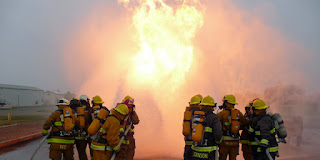Live Fire Training: The Importance of Hands-On Firefighting Experience
Live fire training is a crucial aspect of
training for firefighters, providing them with the essential hands-on
experience required to respond effectively to fires. This type of training
involves setting controlled fires in a safe environment, allowing firefighters
to practice extinguishing fires in a realistic setting. In this article, we
will discuss the importance of live fire training and what it entails.
What
is Live Fire Training?
Live fire training involves setting controlled fires in a safe
environment, such as a specially designed training facility or a designated
outdoor area. These fires are controlled by experienced trainers who ensure
that they are safe and manageable. During the training, firefighters are
provided with hands-on experience using firefighting equipment, such as hoses,
nozzles, and extinguishers, to extinguish the fires.
Why
is Live Fire Training Important?
Live fire training is essential for several
reasons. First and foremost, it provides firefighters with the practical
experience required to respond effectively to fires. This experience is
crucial, as it allows firefighters to learn how to control and extinguish fires
in a realistic setting, developing their skills and confidence.
Second, live fire training enables
firefighters to practice using firefighting equipment in a safe and controlled
environment. This equipment can be complex and difficult to operate, and live
fire training allows firefighters to gain experience using it, enabling them to
use it more effectively during real emergencies.
Third, live fire training provides an opportunity for firefighters to
experience the effects of a real fire. This includes the heat, smoke, and
potential for sudden changes in conditions. This experience is invaluable, as
it provides firefighters with a sense of what to expect during a real fire,
allowing them to prepare accordingly.
What
Does Live Fire Training Entail?
Live fire training is typically conducted in a
specially designed training facility or a designated outdoor area. The facility
is designed to simulate a realistic fire environment, complete with obstacles,
smoke, and heat. During the training, firefighters are provided with hands-on
experience using firefighting equipment, such as hoses, nozzles, and
extinguishers, to extinguish the fires.
The live fire training is conducted by
experienced trainers who ensure that the fires are safe and manageable. The
trainers also provide guidance and feedback to the firefighters, helping them
to develop their skills and confidence.
Safety
Considerations
While live fire training is essential for
firefighters, it is also inherently dangerous. It is essential to ensure that all
safety measures are in place to minimize the risk of injury or death. Safety
considerations include:
1.
Protective Gear
Firefighters must wear appropriate protective
gear, including fire-resistant clothing, gloves, and helmets, to minimize the
risk of injury.
2.
Equipment Maintenance
All firefighting equipment must be in good
working order, regularly maintained, and inspected to ensure that it is safe to
use.
3.
Trained Personnel
Live fire training must be conducted by
experienced personnel who have undergone extensive training in firefighting,
safety, and emergency procedures.
4.
Emergency Response Procedures
All live fire training must have
well-established emergency response procedures in place. This includes having
medical personnel on standby, and emergency communication systems to contact
outside help if necessary.
Conclusion
In conclusion, live fire training is an essential component of firefighter
training. It provides firefighters with the hands-on experience required to
respond effectively to fires, enabling them to control and extinguish fires in
a realistic setting. While live fire training is inherently dangerous, with the
proper safety measures in place, it can be conducted safely, providing
firefighters with the practical experience required to respond effectively to
fires. It is important that all firefighters undergo live fire training to
ensure that they are adequately prepared to respond to emergencies and protect
the public and property from fire.



Comments
Post a Comment